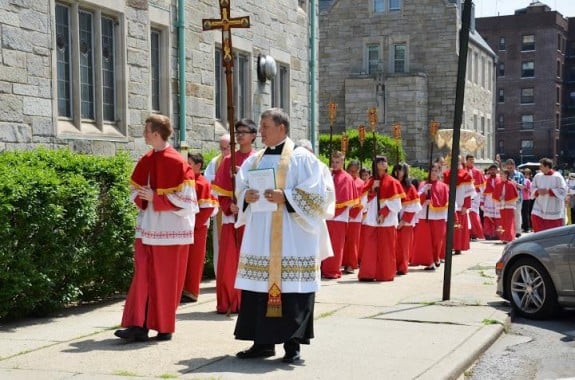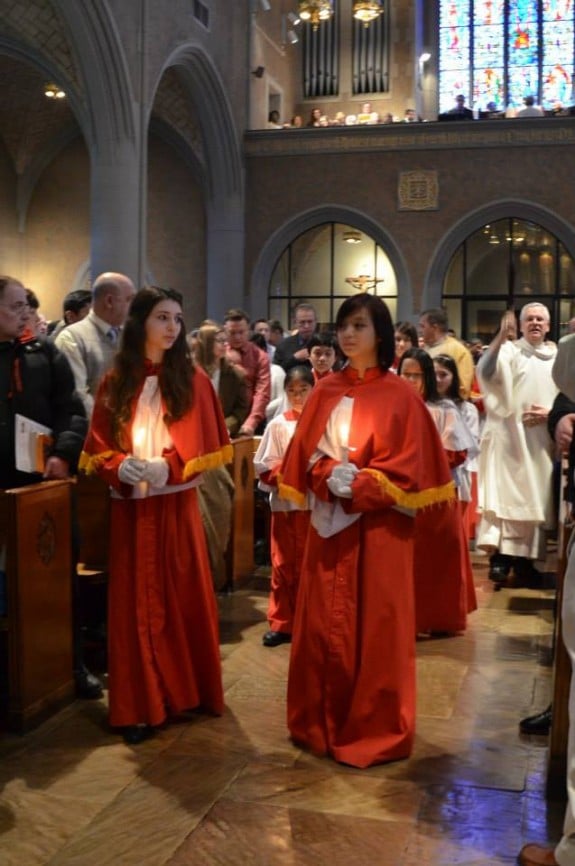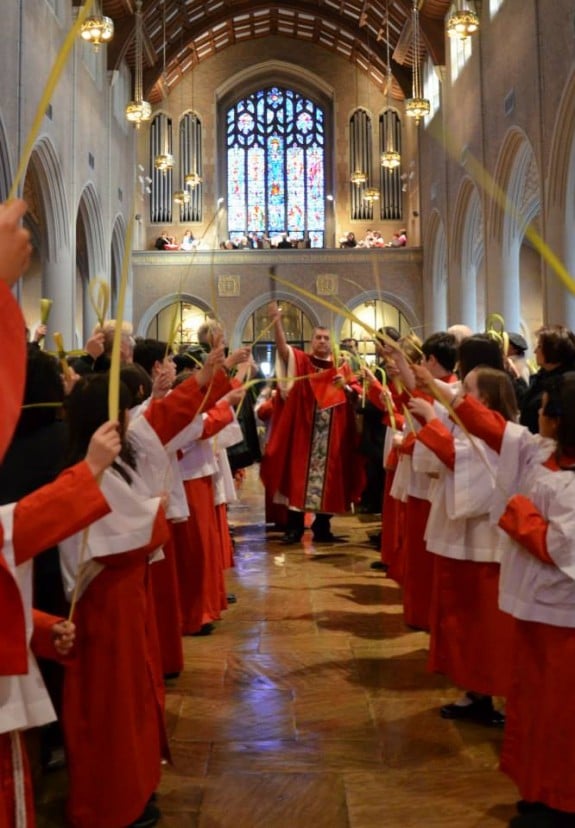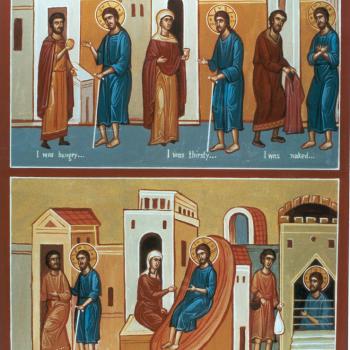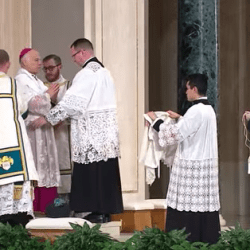People who visit The Bench regularly know that I never tire of gushing about my parish’s altar servers. We have about 140 of them, boys and girls, aged 9-22. As I’ve posted pictures and sung their praises, readers have asked repeatedly, “How do you do it? What’s the secret?”
Well, after much prodding, the moderator of our altar servers has finally written a tell-all, explaining how our program works.
David James (shown in the center above) has been doing this for a long time—and I don’t think anybody does it better. He has a true gift for ministering to young people. David graduated at the top of his class from St. Francis College and holds an M.A. from Fordham University in history. He has spent almost every summer at camp for as long as he can remember and has worked for 13 summers at Buckley Day Camp, where he is currently an administrator. He took over moderating the altar servers at our parish in February 2000 and has remained involved ever since. Under his leadership the enrollment of the altar servers has increased in every single year. In the fall of 2011, he began a parish youth group for teenagers that has more than doubled in size since its first meeting and currently has nearly 80 members.
He was married in June of 2010 and he and his wife are currently expecting their first child—who is destined, no doubt, to serve at the altar someday.
So for those who have been asking: here’s David’s epic account of the altar server program at Our Lady Queen of Martyrs in Forest Hills, New York. It won’t work for everyone, under all circumstances—and it takes time and effort. But the results speak for themselves. The program keeps growing, kids keep staying involved in church, some parents who were once indifferent to the faith come back to the pews week after week—and as an added bonus, we get some nice liturgies, to boot.
+++
“How to Build an Awesome Altar Serving Program in Ten Relatively Easy Steps!”
by David James
1) Sell, Sell, Sell
I think that finding ways for kids to be active participants in the church—and in liturgy, specifically— is incredibly important. Kids who are active in church at a young age turn into adults who are active members of their parishes. The choir members, EMHCs, ushers, lectors and parish council members of tomorrow have to come from somewhere. To say nothing of the fact that tomorrow’s priests, brothers and nuns don’t spring from the well as fully-formed adults. No matter how you choose to look at it, the leaders of tomorrow’s Catholic Church at every level are today’s children. If the only message we send them is to sit still, be quiet and don’t disrupt the mass, we are all going to face a real crisis in tomorrow’s Church.
Ask any teacher and they will tell you that students who are actively engaged with their material are the best learners (think back on your own education and I bet your favorite teachers were the ones that made you do something other than sit there and take notes!). So in order to create tomorrow’s Catholics, we need to get children to be actively engaged in the church. We need to start in one place, the quintessential part of the Catholic experience: the Mass.
Okay, so if getting kids involved in Mass is so important: how do we do it? The answer is almost as obvious as the question: have a sales pitch. The fact of the matter is that most kids don’t know that they should or can be involved with their church; many parents don’t know enough to teach them that they should. Those parents that do often don’t know how to get them involved without arguing with them. More importantly, they do not know who they can trust with their kids. Every September, I make appointments with all of the parochial school teachers and Religious Ed teachers in 4th grade and up. (For those curious: I start my program beginning in the 4th grade and open up to all grades for new recruits every year). I make registration forms and book the church for training classes and then I go and sell my program. I go to each class and introduce myself, tell them who I am and why I’m there. I explain what an altar server is and what we do (a lot of them don’t know). I tell them about all of the cool stuff that we are going to get to do. I tell a lot of jokes. I smile, a lot. Most importantly, I tell them why this is something they should really consider doing. I share with them why I started and why being involved in church is important.
Bottom line: kids are far more likely to sign up for something if they know who is in charge. They are definitely more likely to sign up for something that they perceive as fun and rewarding (and altar serving should be fun and rewarding. If it’s not, you’re doing something wrong. Or as I like to put it: we do a serious thing in a fun way!) I don’t put notices for sign-up in my church bulletin; I find them very impersonal. If you don’t have a school or a Religious Ed program to draw from, talk to your pastor. Ask if you could speak after the announcements for a few moments one Sunday. Let them see you and get to know you. You might be shocked who shows up!
2) Get to know the kids and I don’t just mean their names!
I have nearly 140 altar servers in my program. I make it my goal every year to learn every single name of everyone involved with my program. Then, I try to get to know them. I find out their favorite TV shows, video games, foods, sports, activities and music groups. If I’m not already familiar with them, I make sure that I am as soon as I can (I have listened to way too much Taylor Swift and One Direction the past few years). I make sure that every time I see them I ask about their weekend, their soccer team, their science test. I try to let every child know that I am interested in them and how they are doing.
However, if you want to connect with the kids on a real level, you have to be willing to share. Never ask kids to tell you about themselves without volunteering something about yourself. For example, every altar server knows that I love Starbursts, Dr. Pepper, Star Wars and Batman. I also talk about my faith, why I love being involved in church and about my crippling fear of ice skating.
It’s important that everyone feel welcome and included in your group. It’s also important that they feel like being there is important and that someone would miss them if they weren’t there. All of that starts with you and the tone that you take as you go about your work.
3) The kids are your audience! The parents are your partners!
Time to deal with reality. Parents are disinclined to trust anyone from the Catholic Church that wants to spend time with their kids. They don’t trust you and, to be honest, I don’t blame them. The servers are your audience. You have to teach them, entertain them and hopefully, inspire them, but if you ever want to have long-term, lasting success, their parents need to be your partners.
Every September, I attend our school’s annual Back to School Night. Why? So I can introduce myself to all of the parents. So I can tell them who I am, why I’m qualified to watch their kids, why I do what I do and what my goals are for the program. It’s also a chance for them to ask me questions—and believe me, they have questions. A lot of them have to deal with who is watching their kids and if their kids are safe. Once you get those questions out of the way, everything becomes a little bit easier. Also, if you can sell the parents on the goals and merits of your program, they will try that much harder to get their kids involved. Also, most 4th and 5th graders (and some 7th and 8th graders) can’t get themselves to Mass on their own. If you want the kids to be at Mass and be on the altar, it helps to get the parents on your side. One of the really cool things that I’ve seen happen in recent years is that many of the parents, lapsed Catholics themselves, have found themselves in the church for the first time in years. Many of them keep coming back.
4) Track Everything but Don’t Take Attendance
I track every single number associated with the altar server program (the youth group too for that matter). I know how many kids sign up in 4th grade, how many sign up the next year because they saw how much fun their friends have, I know how many leave after each year, I know how many come from RE, how many come from the school, who goes to what high school, who volunteers for Christmas and Easter Masses each year. The one thing I don’t track is attendance. I want the kids to want to be at church, not feel like they are fulfilling an obligation or commitment. Moreover, I don’t want them to feel like I am going to be angry with them if they get sick or have a family emergency or the car doesn’t start that morning. That’s not to say I don’t pay attention to who shows up. I do! When I see someone misses Mass I try to ask them about it the next time I see them, but in a friendly way. “Hey Jack, I saw you missed Mass, everything ok?” The kids feel like they were missed but don’t feel bad about themselves (they also don’t start viewing me as a traffic cop!) It can also be a great way to start a conversation with the child (and Mom or Dad) about priorities. I know you had baseball practice, but was that really more important than church? Some of them may have never been asked that question before.
While we’re on the topic a quick word about scheduling. I assign the kids to the Mass of their choice (we have five weekend Masses) once every three weeks. Why make things difficult when you don’t have to? They pick a time that is convenient for them and their families and can plan their lives accordingly. For Christmas and Easter Masses, I take requests for each of the “special Masses.” I sell all of them on the magical experience of Midnight Mass, or the beauty of the Holy Thursday procession, or getting to watch the really cool bonfire at the Easter Vigil. This past Midnight Mass, 54 servers came to serve! See what happens when you ask?
5) David’s Unbreakable Rule or Why I Never Say NO!
There are lots of rules when it comes to altar serving. I have a dress code that I enforce to the best of my ability. I ask that everyone show up 15 minutes early so that they can get ready and put themselves in a prayerful mood. I ask that under no circumstances do they wear Crocs or Uggs! All of those rules are important but they are all pretty flexible. I’ve served in sneakers at a moment’s notice and I’ve let others do that as well. I’ve walked into the sacristy two minutes before Mass has started as have a lot of others. Those are rules. But like most rules, it’s more important that everyone understand the spirit behind the rule, not just fear the enforcement of it.
I do have one unbreakable rule: I never say no! I don’t mean that everyone always gets the job they want (I’d need a lot more thuribles). I mean that whenever any altar server walks into the sacristy looking to serve I never, ever turn them away. When an altar server asks to serve at Christmas or Easter, or Corpus Christi, I never turn them away. My promise to them is simple: any time that you show up to serve, assigned or not,I will find a place for you on the altar. I have found space for 55 people on our altar. I have roped off pews in the church for extra altar servers. I have also found and created a plethora of jobs for them to do. I do everything I can to find them a way to participate and be a part of the celebration of the Mass. If this seems a little like overkill and you don’t necessarily want 17 servers at your Sunday Mass, that’s fine. But I ask you the question that I ask anyone that has ever complained about all of the kids (hardly anyone, to be honest): “These are children who are volunteering, asking to serve at the Lord’s altar, no one made them come here, they wanted to be here. Who are you to tell them no?” Jesus certainly didn’t tell them no. For my part, neither will I.
6) Don’t treat kids like little adults.
I once worked with a priest who spoke to the kids like they were miniature adults. He yelled at them when they didn’t do exactly what he wanted. He got angry when they talked or made mistakes. He dismissed their fears or concerns as irrational or irrelevant. Needless to say, the kids did not like him at all. (When he was around the kids I can’t say I was much of a fan; the rest of the time he was an exemplary priest). This may seem obvious, but kids are kids for a reason. They don’t know everything that adults do. It’s our job to teach them.
They don’t know what transubstantiation is, or how to pronounce it. Explain it them. They might not know what a ciborium is, where it goes or why we use it. Teach them. They may not know what the Easter Vigil is and what happens there. Invite them to come and see. Teach them why it is so magical, explain what’s happening. Also remember they will make mistakes. Don’t get upset; help them fix them. There’s also nothing wrong with having a rehearsal for big Masses; soccer teams practice for games, why can’t we practice for Mass?
7) An Aspirational Arc
One day I was sitting in a camp-planning retreat. (Full confession: I have attended every summer of my life and I love it. One of my life goals is to open a summer camp based around Catholic values. Step one: win the lottery…). The consultant starting talking about aspirational arcs. I looked around the room and everyone seemed to be nodding in agreement, but I had no idea what he was talking about. After a few minutes I stopped him and asked him if he could explain what an “aspirational arc” was and why he kept talking about them. The simple explanation is that an aspirational arc is structuring your program so that as children progress, they have milestones to aspire to. Once they have reached those milestones they progress to different age-appropriate aspirations. To put it another way: it’s making sure that your program ages with your kids. You can’t have a 7th grader do the same things that a 4th grader does or that a 10th grader does. You need to keep giving your servers new goals and new challenges to keep them interested. As the servers in my program age, one of their responsibilities is to help and teach the younger servers. You should see how excited they the first time that they get to be a torch master or an assistant MC. I even have started to informally assign buddies to the younger kids as they become servers.
One of the true benefits of structuring the program like this has been that the servers have taken on a sense of ownership for the program. It has become their program. They lead it, the teach the younger kids, they show up early and stay late to make sure that things are clean and put away, they practice for extra masses and make sure that things are done right. A lot of the time all I do when I go to Mass is watch them do their thing!
8) Have some traditions!
Our church in many ways is built upon traditions: traditions that go back millennia to the first apostles, traditions that are still vibrant and alive today. That doesn’t mean that you can’t start some of your own, for your group. For example, before every “big” Mass right before we start, all of the altar servers pray the “Hail Mary”. A few years ago, the kids started a tradition of their own that has really taken off: during the “Our Father”, all of the altar servers gather on one side of the altar and hold hands in a spirit of fellowship. (It drives our beloved Deacon nuts, but I think that it’s great.) Perhaps our most popular tradition is “Story Time.”. I know it’s hard for adults to understand this, but serving Mass— especially a big Mass at Christmas and Easter—can be a harrowing experience for a child. Often their entire family is there, there are bright lights and a big crowd. They have to serve Mass in front of all of those people and are terrified that they might make a mistake. As a way to take off some of the pressure, I started telling stories before Mass. I usually told stories about the times that I had made mistakes on the altar and how everything had turned out fine in spite of my colossal and epic fails.
By doing this, I hope to reassure them that—even if they had made a mistake— everything would be okay. That part worked, but one of the side effects was that it created a communal event that everyone looked forward to. It was a bonding moment for all of us and it made us a closer, more unified group. They wait to hear every year at our altar server installation about how I kicked the bells across the altar at my first Mass, or dropped the cross at Christmas Day Mass, or got hit in the face with the thurible on Holy Thursday. This past year at Midnight Mass I was a little late for story time and when I walked in some of my older servers had picked up the slack and started telling their own stories about their time as altar servers. It’s become part of who we are to gather together, pray and laugh. Traditions like this are what create group unity and cohesion. They also help create a group identity by giving everyone a shared history. It doesn’t matter that they weren’t there when I dropped a cross or kicked the bells; they have become a part of that history in the re-telling of the story. Our church is built upon traditions, our programs should be too.
9) The Three F’s
Every year, as a reward for their hard work and dedication, my parish raises money to send the altar servers to a local amusement park. It’s a great reward for everything they do during the year, but our annual trip serves several important purposes. It reinforces the idea that our parish places a value on the work that the kids do. We could send them hiking, to laser tag or to a pool, it really doesn’t matter. What does matter is that the kids are rewarded for what they do.
Now as much fun as our annual trip is, one thing that I tell people constantly is that even if there isn’t a local amusement park they should find a way to go someplace cool and do something fun. If you can, schedule a day at a retreat house and build a day around that. Prayer should absolutely be a part of what you do, but make sure that the kids have fun. Play football or ultimate frisbee. Organize a video game tournament. Host a movie night. For every activity that I plan, I make sure that it has three distinct elements—or as I teach my older servers and assistants, the three F’s. Everything we do with the kids should be a mixture of fun, fellowship and faith. My annual youth Christmas party is a great example. We have an annual team competition (fun!), followed by food and time for everyone to just hang out (fellowship) and finally an interactive prayer service (faith!). It’s a simple formula, but it works great. Why? Most kids are conditioned by society to view prayer (and most religious activities) as something passive and therefore, boring. While I don’t believe that, and work exceedingly hard to make sure that nothing I do falls into the boring category, sometimes a spoonful of sugar (fun!) makes the medicine go down. You’ll bring everyone closer together, bond with the kids and their parents yourself and before you know it the kids will stop associating church with boring and start associating it with fun. Once they do that, they’ll keep coming back!
10) Love What You Do!
Well duh? Enthusiasm and energy are contagious. If you have it, the kids will pick up on it. More than anything else—more than the trip, more than the planning, more than the organization, more than the recruiting and interactions—this has been the key ingredient to my success with the altar servers. I love what I do. I bring energy and enthusiasm to everything I do and that trickles down. I have always found that if you are dedicated and energetic, if you put in the proper time and planning and trust in the Holy Spirit to guide you, things have a way of working out.

